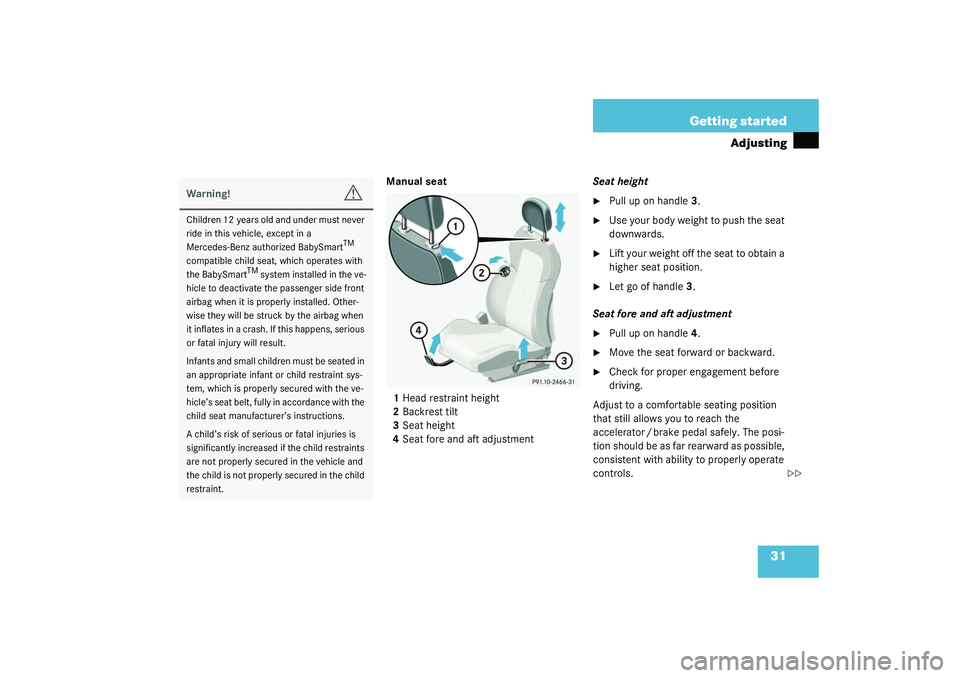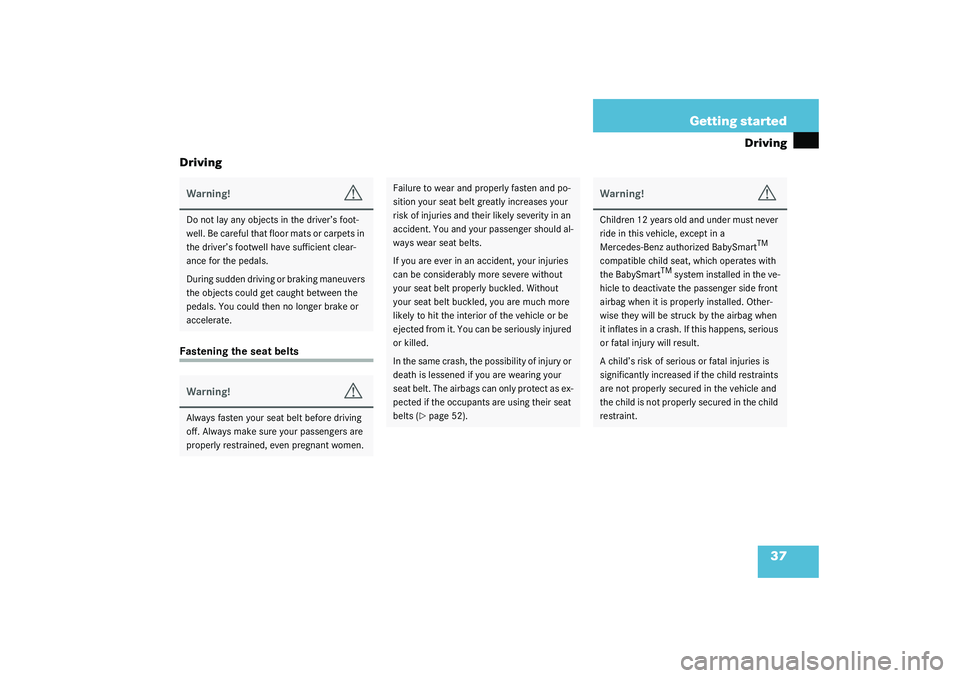Page 29 of 304

29 Getting started
Unlocking
Steering lock positionsSteering lock0For removing key
The steering is locked when the key is
removed from the steering lock. If nec-
essary, move steering wheel slightly to
allow the locking mechanism to en-
gage.
1Power supply to some electrical con-
sumers, such as seat adjustment
2Ignition (power supply for all electrical
consumers) and driving position
3Starting position
Warning!
G
When leaving the vehicle, always remove the
key from the steering lock and lock the vehi-
cle. Do not leave children unattended in the
vehicle, or with access to an unlocked vehi-
cle. Unsupervised use of vehicle equipment
may cause an accident and/or serious per-
sonal injury.iThe key can only be withdrawn in
position0.
If necessary, move steering wheel
slightly to allow the key to be turned
clockwise to position1.
Vehicles with automatic transmission:
The key can only be removed from the
steering lock with the gear selector
lever in positionP.
!To prevent accelerated battery dis-
charge and a possible dead battery,
always remove the key from the
steering lock.
Page 30 of 304

30 Getting startedAdjusting
AdjustingSeats
The seats can be adjusted either manually
or electrically, depending on the vehicle’s
equipment.Warning!
G
All seat, head restraint, steering wheel, and
rear view mirror adjustments, as well as fas-
tening of seat belts, must be done before
the vehicle is put into motion.
Warning!
G
Do not adjust the driver’s seat while driving.
Adjusting the seat while driving could cause
the driver to lose control of the vehicle.
Never ride in a moving vehicle with the seat
back reclined. Sitting in an excessively re-
clined position can be dangerous. You could
slide under the seat belt in a collision. If you
slide under it, the belt would apply force at
the abdomen or neck. That could cause se-
rious or fatal injuries. The seat back and seat
belts provide the best restraint when the
wearer is in an upright position and belts are
properly positioned on the body. Your seat
must be adjusted so that you can correctly
fasten your seat belt (
�page 37).
Never place hands under the seat or near
any moving parts while a seat is being ad-
justed.
Warning!
G
When leaving the vehicle, always remove the
key from the steering lock and lock your ve-
hicle.
The power seats* can also be operated with
the driver’s or passenger door open. Do not
leave children unattended in the vehicle, or
with access to an unlocked vehicle. Unsu-
pervised use of vehicle equipment may
cause an accident and/or serious personal
injury.
Page 31 of 304

31 Getting started
Adjusting
Manual seat
1Head restraint height
2Backrest tilt
3Seat height
4Seat fore and aft adjustmentSeat height
�
Pull up on handle3.
�
Use your body weight to push the seat
downwards.
�
Lift your weight off the seat to obtain a
higher seat position.
�
Let go of handle3.
Seat fore and aft adjustment
�
Pull up on handle4.
�
Move the seat forward or backward.
�
Check for proper engagement before
driving.
Adjust to a comfortable seating position
that still allows you to reach the
accelerator / brake pedal safely. The posi-
tion should be as far rearward as possible,
consistent with ability to properly operate
controls.
Warning!
G
Children 12 years old and under must never
ride in this vehicle, except in a
Mercedes-Benz authorized BabySmart
TM
compatible child seat, which operates with
the BabySmart
TM system installed in the ve-
hicle to deactivate the passenger side front
airbag when it is properly installed. Other-
wise they will be struck by the airbag when
it inflates in a crash. If this happens, serious
or fatal injury will result.
Infants and small children must be seated in
an appropriate infant or child restraint sys-
tem, which is properly secured with the ve-
hicle’s seat belt, fully in accordance with the
child seat manufacturer’s instructions.
A child’s risk of serious or fatal injuries is
significantly increased if the child restraints
are not properly secured in the vehicle and
the child is not properly secured in the child
restraint.
��
Page 32 of 304

32 Getting startedAdjusting�
Let go of handle4. The seat should
make an audible click.
Backrest tilt
�
Turn handwheel2 forward or backward
until your arms are slightly angled
when holding the steering wheel.Head restraint height
�
Adjust the height of the head restraints
by pulling them upwards manually.
�
For a lower position, press release
button1 and push down on the head
restraints manually.
More information can be found in the
“Controls in detail” section (
�page 82).Power seat*
�
Switch on the ignition by turning the
key in the steering lock to position2.
or
�
Open the driver’s or passenger door.
The seat adjustment switches are located
on the outer sides of the seats.
1Seat height
2Seat fore and aft adjustment
3Seat cushion tilt
4Backrest tilt
iWhen moving the seat, be sure that
there are no items in the footwell or
behind the seats. Otherwise you could
damage the seats.
Warning!
G
For your protection, drive only with properly
positioned head restraints.
Adjust head restraint to support the back of
the head approximately at ear level.
Do not drive the vehicle without the seat
head restraints. Head restraints are intend-
ed to help reduce injuries during an acci-
dent.
Page 33 of 304

33 Getting started
Adjusting
Seat height�
Press the switch up or down in the di-
rection of arrow1.
Seat fore and aft adjustment
�
Press the switch forward or backward
in the direction of arrow2.
Adjust to a comfortable seating position
that still allows you to reach the
accelerator / brake pedal safely. The posi-
tion should be as far to the rear as possi-
ble, consistent with ability to properly
operate controls.
Seat cushion tilt
�
Press the switch up or down in the di-
rection of arrow3 until your upper legs
are lightly supported.Backrest tilt
�
Press the switch forward or backward
in the direction of arrow4 until your
arms are slightly angled when holding
the steering wheel.
Head restraint height
5Release button
�
Adjust the height of the head restraints
by pulling them upwards manually.
�
For a lower position, press release
button5 and push down on the head
restraints manually.
More information can be found in the
“Controls in detail” section (
�page 82).
iWhen moving the seat, be sure that
there are no items in the footwell or
behind the seats. Otherwise you could
damage the seats.
Warning!
G
For your protection, drive only with properly
positioned head restraints.
Adjust head restraint to support the back of
the head approximately at ear level.
Do not drive the vehicle without the seat
head restraints. Head restraints are intend-
ed to help reduce injuries during an acci-
dent.
Page 34 of 304

34 Getting startedAdjustingTelescoping steering column* Steering wheel adjustment
1Adjustment handle
�
To unlock the steering column, pull out
handle1 as far as it will go.
�
Move the steering wheel to the desired
position.
�
Push handle1 back to its original posi-
tion to relock the steering wheel. You
should hear an audible click.
The steering wheel is again fixed into
place.
Warning!
G
Do not adjust the steering wheel while driv-
ing. Adjusting the steering wheel while driv-
ing, or driving without the adjustment
locked could cause the driver to lose control
of the vehicle.
When leaving the vehicle, always remove the
key from the steering lock and lock your ve-
hicle.
Do not leave children unattended in the ve-
hicle, or with access to an unlocked vehicle.
Unsupervised use of vehicle equipment may
cause an accident and/or serious personal
injury.
!Do not drive the vehicle until you have
properly locked the steering column.
If the indicator lamp
_
comes on
while the engine is running, the steer-
ing column is not locked properly
(
�page 200).
Page 35 of 304

35 Getting started
Adjusting
Mirrors
Adjust the inside and exterior rear view
mirrors before driving so that you have a
good view of the road and traffic condi-
tions.Inside rear view mirror
�
Manually adjust the inside rear view
mirror.
Exterior rear view mirrorThe switch is located on the center
console.
1Driver’s side mirror
2Passenger side mirror
�
Make sure that the ignition is switched
on.
All the lights in the instrument cluster
light up.
Warning!
G
In the case of an accident, liquid electrolyte
may escape the mirror housing if the mirror
glass breaks.
Electrolyte has an irritating effect. Do not al-
low the liquid to come into contact with
eyes, skin, clothing, or the respiratory sys-
tem. In case it does, immediately flush af-
fected area with water, and seek medical
help if necessary.
Warning!
G
Exercise care when using the passenger
side exterior rear view mirror. The mirror
surface is convex (outwardly curved surface
for a wider field of view). Objects in mirror
are closer than they appear. Check your in-
side rear view mirror or glance over your
shoulder before changing lanes. !Electrolyte drops coming into contact
with the vehicle paint finish can only be
completely removed while in their liq-
uid state and by applying plenty of wa-
ter.
��
Page 37 of 304

37 Getting started
Driving
Driving
Fastening the seat beltsWarning!
G
Do not lay any objects in the driver’s foot-
well. Be careful that floor mats or carpets in
the driver’s footwell have sufficient clear-
ance for the pedals.
During sudden driving or braking maneuvers
the objects could get caught between the
pedals. You could then no longer brake or
accelerate.Warning!
G
Always fasten your seat belt before driving
off. Always make sure your passengers are
properly restrained, even pregnant women.
Failure to wear and properly fasten and po-
sition your seat belt greatly increases your
risk of injuries and their likely severity in an
accident. You and your passenger should al-
ways wear seat belts.
If you are ever in an accident, your injuries
can be considerably more severe without
your seat belt properly buckled. Without
your seat belt buckled, you are much more
likely to hit the interior of the vehicle or be
ejected from it. You can be seriously injured
or killed.
In the same crash, the possibility of injury or
death is lessened if you are wearing your
seat belt. The airbags can only protect as ex-
pected if the occupants are using their seat
belts (
�page 52).
Warning!
G
Children 12 years old and under must never
ride in this vehicle, except in a
Mercedes-Benz authorized BabySmart
TM
compatible child seat, which operates with
the BabySmart
TM system installed in the ve-
hicle to deactivate the passenger side front
airbag when it is properly installed. Other-
wise they will be struck by the airbag when
it inflates in a crash. If this happens, serious
or fatal injury will result.
A child’s risk of serious or fatal injuries is
significantly increased if the child restraints
are not properly secured in the vehicle and
the child is not properly secured in the child
restraint.